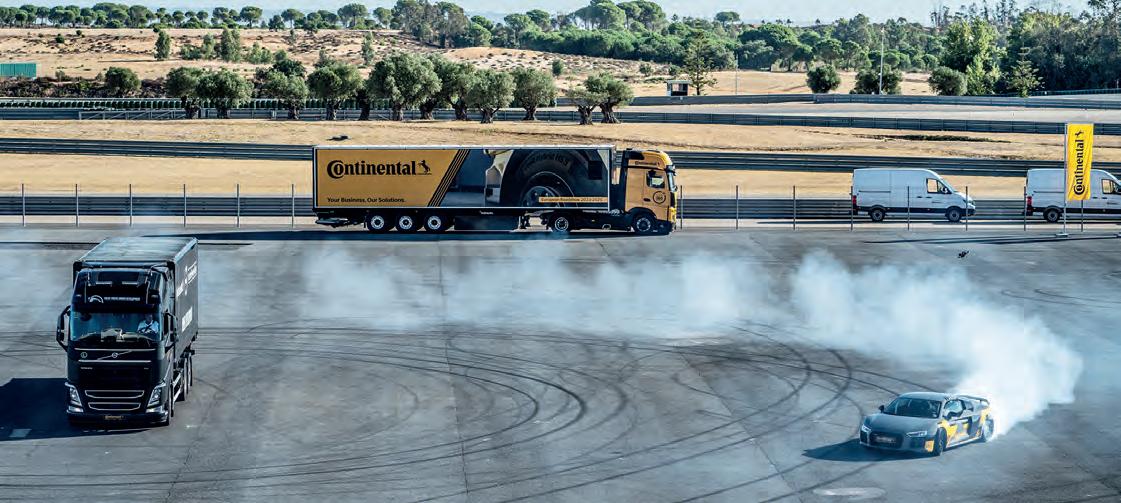
5 minute read
Continental launches Generation 5 Conti Hybrid
CONTINENTAL TURN UP THE HEAT WITH GENERATION 5 CONTI HYBRID
Continental certainly turned up the heat in more ways than one when they invited us to a spectacular Press launch of their new Generation 5 Conti Hybrid tyre line, as Export & Freight’s Phil Eaglestone reports from Seville in Spain.
The launch of the new Conti Hybrid HS5 and HD5 - and a new VanContact A/S Ultra for the delivery van market – included some breath-taking displays under a midday sun that saw the temperature shoot up to a sweltering 37C; it was a tough day, but someone had to do it! Getting the ball rolling for Generation 5 is the Conti Hybrid HS5 for the steer axle and the Conti Hybrid HD5 for the drive axle – in 22.5-inch format for combined use on regional roads and highways. The tyres meet the diverse requirements of heavy-duty fleet use, i.e. frequent acceleration, braking, manoeuvring and cornering on a variety of road surfaces. The new premium tyres rise to the myriad challenges with an array of cutting-edge developments; innovative treads, rubber compounds and state-of-the-art casing constructions deliver superb performance thanks to excellent mileage, durability and traction combined with optimised rolling resistance. This makes the new Conti Hybrid a reliable partner throughout its service life. The new Conti Hybrid Generation 5 tyre line stands out with a mileage up to 20 percent higher than that of the predecessor generation – depending on the tyre size involved. This new tyre line offers fleet operators exceptional overall performance throughout the tyres’ service life, as they have been developed specially to meet the demands of regional transport. “With the high mileage on offer and premium retread solution, the long service life of the tyres helps to achieve a high level of fleet efficiency and therefore ensure sustainable fleet management,” says Hinnerk Kaiser, Head of Product Development Bus and Truck Tyres at Continental. The rubber compounds used by the Conti Hybrid Generation 5 tyre line have been further developed specially to meet the exacting demands of regional transport. The treads, with their two-layer construction (cap base) and innovative compounds, enable a high mileage and considerable robustness while also optimizing rolling resistance in regional transport use. This also has a positive impact on fuel efficiency and CO2 emissions. Both the Conti Hybrid HS5 for the steer axle and the Conti Hybrid HD5 for the drive axle offer topclass performance in all weather conditions and even with residual tread depths towards the end of the tyre life. A robust tread with new, full-width 3D matrix sipes takes the credit here. The newly developed tread structure of the Conti Hybrid HD5 protects the tread and casing very effectively against stone damage at the drive axle. Centre grooves with increasing cavities in the second half of the tyre’s service life and special stone ejectors prevent stones becoming embedded in the tyre.

DELIVERY VAN TYRES
The new VanContact A/S Ultra range, available since last December and being expanded this year, clearly demonstrates how Continental is striving for sustainability in tyres for delivery vans, too, yet without one compromise in safety-relevant tyre characteristics. The new model now being produced in four sizes in a diameter of 16 inches can be installed on vehicles frequently used for delivery services and trade businesses, such as the

Mercedes Sprinter, VW Crafter and Fiat Ducato, as well as on smaller vans like the Mercedes V-Class or VW T6. The product range will be significantly expanded this year to include other sizes of 15-, 16- and 17-inch diameter. Expanding urbanisation, the general trend toward electric mobility also in the transport industry, and the increase in inner-city and door-to-door deliveries have significantly changed mobility habits and requirements. Vans are also commuting and traveling longer distances more frequently, entailing stop-and-go driving in cities as well – and all these demands and requirements are reflected in the design of these new Ultra-series tyres. Continental has developed tyres for this purpose that are robust and durable and offer the safety and rolling resistance performance of premium products. To achieve this high level of progress in tyre properties, Continental engineers have developed a new rubber compound, profile and sidewall. New fillers were added to the rubber compound that reduce rolling resistance – an important factor for low fuel consumption and reduced CO2 emissions. At the same time, the functionalised polymers in this new compound provide for high mileage in both summer and winter use. The “snow traps” – small bars in the tread grooves – are also aimed at winter use, holding the snow in the grooves and thus offering good friction with the snow on the road. They also stabilise the profile and contribute to precise handling and high mileage. The smart 3D sipe was developed to achieve good grip when driving on snow and on wet roads, a special design that stabilises the tread blocks, thereby providing for short braking distances. In winter operation, this design allows the sipe to open wide when rolling into the ground contact area, thus producing high snow grip via the sipe edges. The combination of profile design and rubber compound mitigates the conflict of objectives between mileage and rolling resistance as well as wet grip. Vans operated in urban areas can hardly avoid hard tyre contact with roadside curbs. To ensure the sidewall is ruggedly resistant to such tough conditions, the scuff rib was applied around the entire sidewall. Its “brick pattern” protects the sidewall against damage and thus contributes to making the tyre highly robust. Continental’s engineers have also developed a new, clearly visible tread depth indicator for the new VanContact A/S Ultra. that displays the tyre’s remaining tread depth much better than the small bars in the grooves. Four groups of figures distributed across the tyre circumference on the tread blocks indicate the remaining tread depth between five, four and three millimetres.












